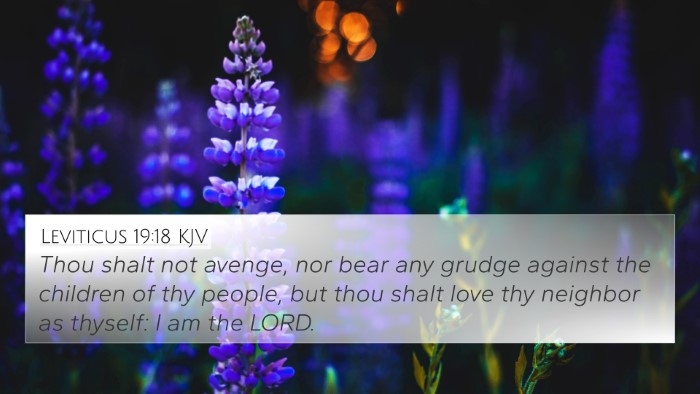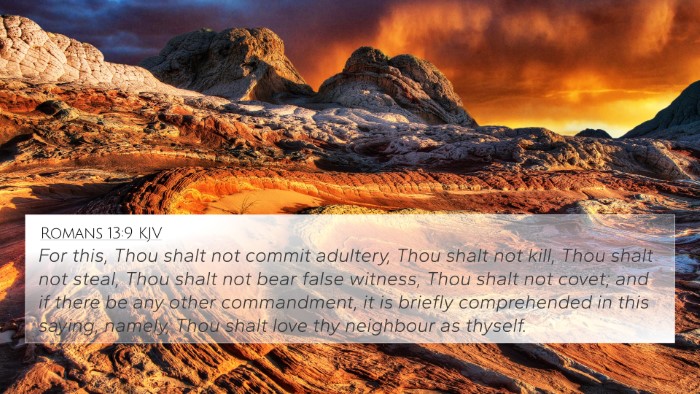Understanding Matthew 22:39
Bible Verse: "And the second is like unto it, Thou shalt love thy neighbour as thyself." (Matthew 22:39, KJV)
This verse forms a vital part of Jesus' teaching on the greatest commandments, where He highlights the importance of love in the life of believers. It underlines the necessity of loving others, equating this love with the love one should have for oneself. Below is a thorough examination of this verse through public domain commentaries.
Commentary Insights
-
Matthew Henry's Commentary:
Matthew Henry emphasizes that love for our neighbor is a reflection of our love for God. He states that loving one's neighbor is rooted in the understanding that all humans are created in the image of God. The commandment to love one's neighbor calls for genuine care, kindness, and a willingness to act in the interest of others, paralleling the love one has for oneself.
-
Albert Barnes' Notes:
Barnes elaborates that this commandment is not merely about feelings of affection but involves actions. It implies treating others with the same consideration and respect that one desires for oneself. This love should extend beyond mere tolerance to active kindness and support, positioning it as a cornerstone in Christian ethics.
-
Adam Clarke's Commentary:
Clarke brings attention to the ethical implications of loving one's neighbor as oneself. He interprets this command as an expression of a broader social responsibility, highlighting that true love for one’s neighbor includes self-sacrifice and a commitment to the well-being of others. Clarke also ties this command to the moral standards established in the Old Testament.
Key Themes and Connections
Matthew 22:39 profoundly connects with various themes within the Bible, such as love, morality, and ethical obligations. Below are some critical themes and connections:
-
Love as Central Commandment:
This verse echoes Leviticus 19:18, symbolizing a continuity of belief and moral instruction from the Old Testament to the New.
-
Self-Love and Other-Centered Love:
The connection between loving oneself and loving others presents a holistic view of Christian love. Ephesians 5:29 also emphasizes nurturing oneself, establishing a Biblical basis for how we view others.
-
Inter-Biblical Dialogue:
Jesus reiterates this command in Luke 10:27, showcasing its significance across the Gospels and reinforcing its relevance in Christian doctrine.
-
The Golden Rule:
Similarities can be drawn to Luke 6:31, where Jesus instructs followers to "do unto others as you would have them do unto you," aligning closely with the message found in Matthew 22:39.
-
Love in Action:
1 John 4:20-21 clarifies that love for God and love for others are inseparable, supporting the mutual obligation to love as highlighted in Matthew 22:39.
-
Community and Relationships:
Acts 2:44-45 illustrates the early church's commitment to one another's needs, embodying the kind of love mandated in this verse.
-
The Fulfillment of the Law:
Romans 13:8-10 suggests that fulfilling the law is achievable through love, reiterating the foundational role of love as seen in Jesus' commandments.
Cross-References for Deeper Study
- Leviticus 19:18 - Foundation of neighborly love.
- Ephesians 5:29 - The Biblical principle of self-love.
- Luke 10:27 - Jesus’ reaffirmation of the commandment.
- Matthew 7:12 - The Golden Rule in ethical teaching.
- 1 John 4:20-21 - Love for God and others as intertwined.
- Acts 2:44-45 - The early church exemplifying love.
- Romans 13:8-10 - Love as the fulfillment of the law.
Conclusion
Matthew 22:39 serves as a powerful reminder of the core of Christian teaching: love—both for oneself and for others. Through various commentaries and scripture cross-references, we observe that this verse not only calls for an internal sentiment of love but also urges towards external actions that reflect that love. By understanding and implementing this commandment, believers can foster a community characterized by compassion, empathy, and genuine care.











